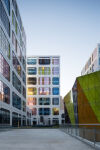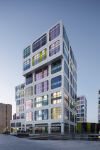Beijing Times Square is located in the center of Beijing Fangshan District. The project consists of seven towers that are organized around a half sunken IMAX plaza with 21 theaters. Asia’s largest LED canopy emphasizes the main entrance to a public area that is organized over three different levels. In total, the project consists of around 138.000 m2 of program and 1.400 underground parking places.

Beijing Times Square
Abundance of color

Exploring architectural compositions

Connecting public programs
To create an open public environment that allows for maximum exchange, the site has been made accessible from all directions. Two levels of public program, one on ground level and one on a sunken plaza level, cross the site diagonally, connecting three main intersections. The main entrance to 21 IMAX theatres of varying sizes is located at the center of the site, potentially creating a maximum traffic flow of pedestrian visitors through the site. A 5000m2 urban LED canopy will emphasize the main public entrance to the site and will create an open connection to the new subway station that is located on the south-east corner of the site.

Creating creative encounters
Around the sunken plaza, seven towers with a maximum height of 80 meters are organised to spatially enclose the central space. In these towers, different SOHO spaces are located. The facade of these towers loosely refer to a collection of different interlocking hands that are used in the film industry to determine screen proportions. A new type of glass in China is used, that is colourful towards the exterior and typical transparent colour towards the interior.







